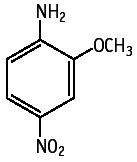

4-Nitro-o-anisidine was mutagenic in Salmonella typhimurium TA100, TA98 and TA1537, with and without an exogeneous metabolic activation system and Salmonella typhimurium TA100, TA1535, TA98 and TA1537 and Escherichia coli WP2 uvrA, with an exogeneous metabolic activation system.
Genotoxicity of 4-nitro-o-anisidine was studied by chromosomal aberration test in cultured Chinese hamster lung (CHL/IU) cells. Structural chromosomal aberrations were induced at 0.080 mg/ml (high concentration) with short-term treatment and an exogenous metabolic activation system. Polyploidy was not induced in any treatment group.
| Purity | : | 99.4% |
| Test species/strain | : | Rat/Crj:CD (SD) |
| Test method | : | Guidelines for 28-day Repeat Dose Toxicity Testing of Chemicals (Japan) |
| Route | : | Oral (gavage) |
| Doses | : | 0 (vehicle), 30, 100, 300 mg/kg/day |
| Number of animals | : | Male, 5; Female, 5/group |
| Vehicle | : | Corn oil |
| Administration period | : | Males and females, 28 days |
| Terminal kill | : | Males and females, Days 29 or 43 |
| GLP | : | Yes |
Absolute and relative spleen and relative liver weights were increased in both males and females receiving 300 mg/kg, and absolute thymus weights were slightly decreased. Histopathological examination revealed increases in myocardial necrosis and extramedullary hematopoiesis in the spleen in both males and females receiving 300 mg/kg. Deposits of pigment in the spleen in females receiving 300 mg/kg were greater than in the controls.
The NOEL for repeat dose toxicity is considered to be 30 mg/kg/day for both sexes.
| Purity | : | 99.4 wt% |
| Test species/strains | : | Salmonella typhimurium, TA100, TA1535, TA98, TA1537, Escherichia coli WP2 uvrA |
| Test method | : | Guidelines for Screening Mutagenicity Testing of Chemicals (Japan) and OECD Guideline No. 471 and 472 |
| Procedures | : | Pre-incubation method |
| Solvent | : | DMSO |
| Positive controls | : | -S9 mix, 2-(2-Furyl)-3-(5-nitro-2-furyl) acrylamide (TA100, TA98, WP2), Sodium azide (TA1535) and 9-Aminoacridine (TA1537) +S9 mix, 2-Aminoanthracene (five strains) |
| Doses | : | -S9 mix; 0, 313, 625, 1250, 2500, 5000 μg/plate (five strains) +S9 mix; 0, 313 - 5000 μg/plate (five strains) and |
| S9 | : | Rat liver, induced with phenobarbital and 5,6-benzoflavone |
| Plates/test | : | 3 |
| Number of replicates | : | 2 |
| GLP | : | Yes |
Test results:
Salmonella typhimurium TA100, TA98, TA1537
| + | ? | - | |
| Without metabolic activation: | [*] | [ ] | [ ] |
| With metabolic activation: | [*] | [ ] | [ ] |
Salmonella typhimurium TA1535
| + | ? | - | |
| Without metabolic activation: | [ ] | [ ] | [*] |
| With metabolic activation: | [*] | [ ] | [ ] |
Escherichia coli WP2 uvrA
| + | ? | - | |
| Without metabolic activation: | [ ] | [ ] | [*] |
| With metabolic activation: | [*] | [ ] | [ ] |
| Purity | : | 99.4 wt% |
| Type of cell used | : | Chinese hamster lung (CHL/IU) cells |
| Test method | : | Guidelines for Screening Mutagenicity Testing of Chemicals (Japan) and OECD Guideline No. 473 |
| Solvent | : | Dimethylsulfoxide |
| Positive controls | : | -S9 mix, Mitomycin C +S9 mix, Cyclophosphamide |
| Doses | : | -S9 mix (continuous treatment):0, 0.050, 0.10, 0.20 mg/m -S9 mix (short-term treatment):0, 0.43, 0.85, 1.70 mg/ml +S9 mix (short-term treatment):0, 0.020, 0.040, 0.080 mg/ml |
| S-9 | : | Rat liver, induced with phenobarbital and 5,6-benzoflavone |
| Plates/test | : | 2 |
| GLP | : | Yes |
Test results:
With short-term treatment and exogenous metabolic activation, structural chromosomal aberrations (12.0%, including gap) were induced at 0.080 mg/ml (high concentration). Polyploidy was not induced in any treatment groups.
Lowest concentration producing cytogenetic effects in vitro:
With metabolic activation (short-term treatment): 0.080 mg/ml (clastogenicity)
Genotoxic effects:
| clastogenicity | polyploidy | |||||
| + | ? | - | + | ? | - | |
| Without metabolic activation: | [ ] | [ ] | [*] | [ ] | [ ] | [*] |
| With metabolic activation: | [*] | [ ] | [ ] | [ ] | [ ] | [*] |
| 1) | The tests were performed by the Biosafety Research Center, Foods, Drugs and Pesticides (An-pyo Center), Japan, 582-2 Shioshinden Arahama, Fukude-cho, Iwata-gun, Shizuoka, 437-12, Japan. Tel +81-538-58-1266 Fax +81-538-58-1393 |
| 2) | The tests were performed by the Hatano Research Institute, Food and Drug Safety Center, 729-5 Ochiai, Hadano-shi, Kanagawa, 257, Japan. Tel +81-463-82-4751 Fax +81-463-82-9627 |